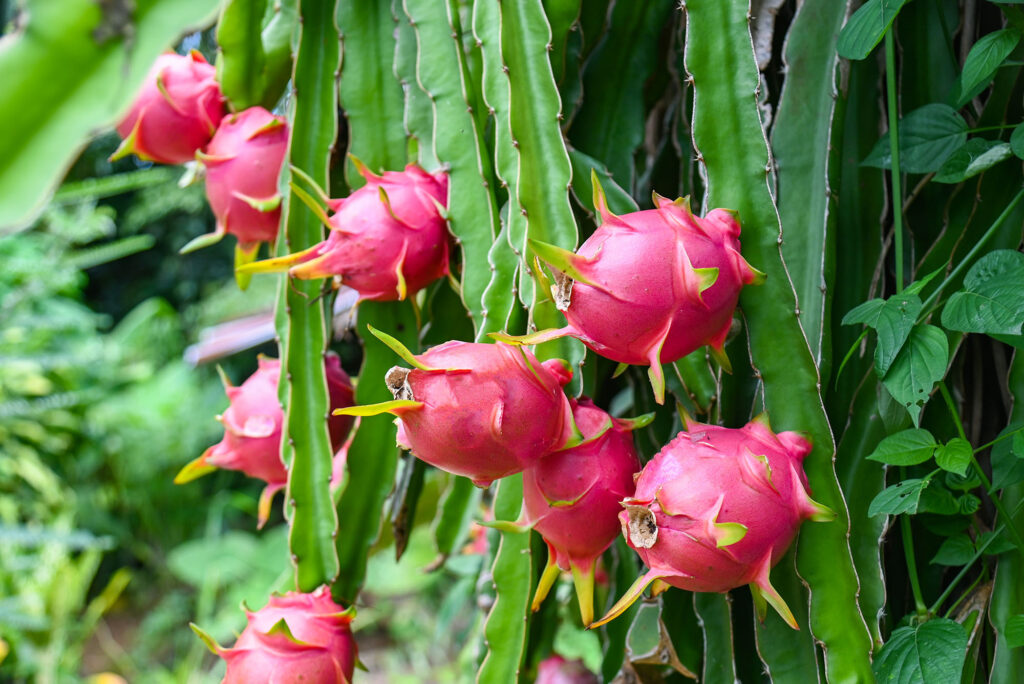Dragon fruit, popularly known as the “dragon fruit,” is an exotic and vibrant fruit that has gained popularity around the world for its unique flavor and health benefits. Native to Central and South America, pitahaya has become a star in the tropical fruit industry due to its eye-catching appearance, refreshing sweetness, and nutritional value. In this article, we will explore the production process of dragon fruit, from its cultivation to its arrival on the tables of consumers around the world.
Cultivation and Agroclimatic Requirements:
Dragon fruit is grown in tropical and subtropical regions, thriving in hot, dry climates with average temperatures between 20°C and 30°C. The plant requires full sun for optimal growth and must be protected from frost and extreme weather conditions. Areas with excessive rainfall can be detrimental to plant development, since excess moisture can lead to fungal diseases. Casas Viejas offers ideal climatic and soil conditions for this crop.
Propagation and Cultivation:
Dragon fruit is propagated by seeds or cuttings from the mother plant. Cuttings are preferred as they maintain the characteristics of the mother plant, while seeds can give rise to genetic variations. The pitahaya plant can grow bushily or climbing, requiring support structures for its vertical growth.
The plant needs a well-drained, sandy soil, with a pH between 6 and 7. Watering is essential during the period of active growth, but excess water should be avoided to prevent root rot problems.
Flowering and Pollination:
The pitahaya is famous for its nocturnal and ephemeral flowers. The giant white flowers open at dusk and close in the morning. Pollination of these flowers is crucial for fruit development. In the wild, bats and nocturnal moths are the main pollinators. In commercial plantations, manual pollination is often carried out using brushes or pollinating insects.
In Casas Viejas, due to its very low exposure to agrochemicals, there is a large population of natural pollinators that facilitate the process, which translates into higher productions.
Watch the video so you can enjoy the flowering on July 29, 2023 at the Finca Clara Mery in Casas Viejas.
Harvest:
Dragon fruit usually begins to bear fruit 24 to 36 months after planting. Fruits are ready for harvest when their color changes from green to pink or yellow, depending on the variety. The fruit is carefully hand-picked as the skin is covered with small, fine thorns. With the increase in hectares of this crop, we hope to create new jobs for the families of Casas Viejas.
Postharvest Process:
After harvesting, dragon fruit undergo a post-harvest process that includes washing, sorting and packaging. Fruits are stored in cool conditions and shipped quickly to preserve their freshness. Dragon fruit has a relatively short shelf life, so it is essential to properly manage the supply chain to maintain its quality.
Market and Consumption:
Dragon fruit has become a popular fruit in international markets due to its visual appeal and nutritional profile. It is rich in antioxidants, fiber, vitamin C and other nutrients beneficial to health. It is consumed fresh, but is also used in juices, smoothies, desserts and gourmet dishes.
Challenges and Future:
Despite its growing popularity, dragon fruit production faces challenges in terms of diseases, climate fluctuations and sustainable resource management. However, the continued demand for this exotic fruit drives research and development of more efficient and sustainable agricultural practices.
Dragon fruit production is a fascinating process that involves a combination of agricultural care, strategic pollination and post-harvest management. From its beginnings in Latin America to its arrival on tables around the world, the pitahaya continues to captivate consumers with its unique flavor and visual appeal, becoming a jewel in the world of tropical fruits.


